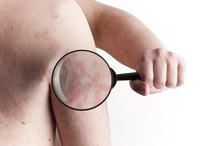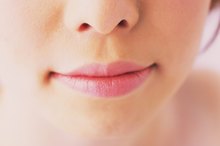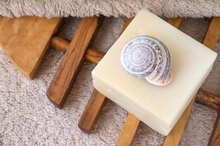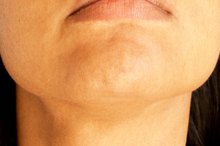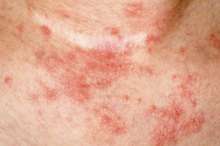Dry Flaking on the Nose
Dry, flaking skin can be an unsightly problem, especially if it occurs in a highly visible area such as your nose. Although dry, flaking facial skin often results from a lack of moisture in the skin due to aging skin or harsh cleaning routines, certain skin conditions can also cause dry skin flakes. If your skin flakes don’t improve with changes to your cleaning routine – or if you also experience itching or inflammation – schedule an appointment with your doctor.
Causes
You might experience flaking or irritation on your nose right after a bad sunburn or an allergic reaction to a lotion or cream. This can be a sign of healing in damaged or irritated skin. 2”
Identification
How to Get Rid of Psoriasis & Eczema
Learn More
Skin flaking due to dry skin often worsens in the winter months when the low humidity of the outdoor air combines with hot indoor air to make your skin dry and parched. Psoriasis patches consist of red, patches of skin covered with flaky silver scales. Eczema, a common skin condition, causes an itchy rash characterized by dry scales or flakes. Seborrheic dermatitis – an inflammatory condition that causes flaky, white to yellowish scales -- occurs most frequently in oily areas, including the scalp, eyelids, lips, behind the ears and in the creases of the nose 1.cause:
- Seborrheic dermatitis – an inflammatory condition that causes flaky
- white to yellowish scales -- occurs most frequently in oily areas
- including the scalp
- eyelids
- lips
- behind the ears
- in the creases of the nose 1
- Skin flaking due to dry skin often worsens in the winter months when the low humidity of the outdoor air combines with hot indoor air to make your skin dry and parched.
- Eczema, a common skin condition, causes an itchy rash characterized by dry scales or flakes.
Prevention/Solution
Adding extra moisture to your skin can treat and prevent flaking caused by dry, parched skin. The American Academy of Dermatology suggests washing your face less frequently and using mild soaps, or soap substitutes, on your skin. Avoid using antibacterial or deodorant soaps on your face, since they can further irritate dry, flaky skin. After washing your face, apply a moisturizer, such as petrolatum or lanolin, to seal in moisture.
- Adding extra moisture to your skin can treat and prevent flaking caused by dry, parched skin.
- After washing your face, apply a moisturizer, such as petrolatum or lanolin, to seal in moisture.
Warning
Can Vaseline Be Used for Dry Scalp?
Learn More
Scratching at your dry, flaking skin can cause secondary bacterial or fungal skin infections. Seek prompt medical attention if the flaking areas become red, swollen or inflamed. Chronic skin conditions like psoriasis or eczema also can affect your self-esteem and cause stress, anxiety and depression. Your doctor can recommend support groups or counselors that can help you learn to live with these conditions.
- Scratching at your dry, flaking skin can cause secondary bacterial or fungal skin infections.
- Chronic skin conditions like psoriasis or eczema also can affect your self-esteem and cause stress, anxiety and depression.
Expert Insight
On his website TotalDermatology.com, Nissan Pilest, MD, a board-certified dermatologist, suggests treating the “face dandruff” caused by seborrheic dermatitis by applying 0.5% to 1% concentrations of cortisone cream, ointment or gel to the affected areas 1.cause:
- On his website TotalDermatology.com
- Nissan Pilest
- MD
- a board-certified dermatologist
- suggests treating the “face dandruff” caused by seborrheic dermatitis by applying 0.5% to 1% concentrations of cortisone cream
- ointment or gel to the affected areas 1
If this treatment fails to help within three weeks, see your doctor.
Related Articles
References
- Medline Plus: Seborrheic Dermatitis
- "Symptoms: Their Causes and Cures"; Prevention Magazine Editors; 1996
- National Psoriasis Foundation: About Psoriasis
- Clark GW, Pope SM, Jaboori KA. Diagnosis and Treatment of Seborrheic Dermatitis. Am Fam Physician. 2015 Feb 1;91(3):185-90.
- Borda LJ, Wikramanayake TC. Seborrheic Dermatitis and Dandruff: A Comprehensive Review. J Clin Investig Dermatol. 2015 Dec;3(2). doi:10.13188/2373-1044.1000019
- American Academy of Dermatology. What is psoriasis?
- American Academy of Dermatology. Seborrheic Dermatitis.
- National Eczema Association. Seborrheic Dermatitis.
Writer Bio
A former children's librarian and teacher living in Dallas, Erin Carson loves to share her knowledge of both literature and parenting through her writing. Carson has a master's degree in library science and a bachelor's degree in English literature. As a freelance writer, Carson has published numerous articles on various websites.
